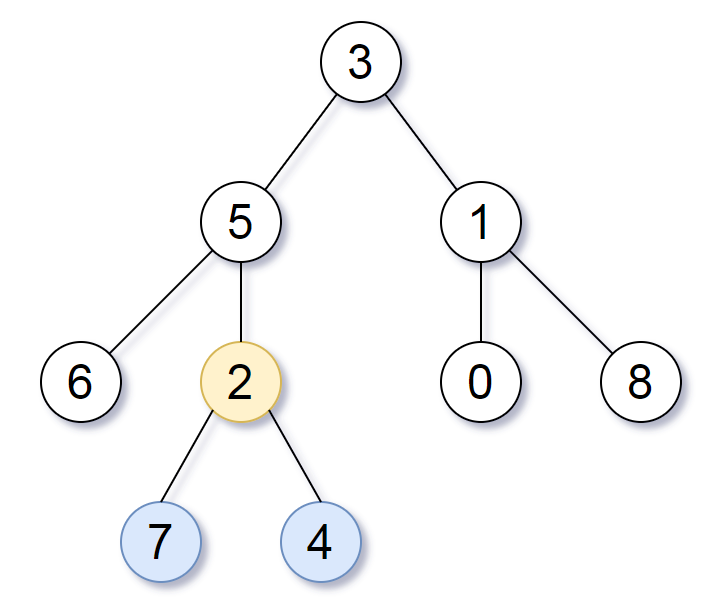| comments | difficulty | edit_url | tags | |||||
|---|---|---|---|---|---|---|---|---|
true |
中等 |
|
给定一个根为 root 的二叉树,每个节点的深度是 该节点到根的最短距离 。
返回包含原始树中所有 最深节点 的 最小子树 。
如果一个节点在 整个树 的任意节点之间具有最大的深度,则该节点是 最深的 。
一个节点的 子树 是该节点加上它的所有后代的集合。
示例 1:
输入:root = [3,5,1,6,2,0,8,null,null,7,4] 输出:[2,7,4] 解释: 我们返回值为 2 的节点,在图中用黄色标记。 在图中用蓝色标记的是树的最深的节点。 注意,节点 5、3 和 2 包含树中最深的节点,但节点 2 的子树最小,因此我们返回它。
示例 2:
输入:root = [1] 输出:[1] 解释:根节点是树中最深的节点。
示例 3:
输入:root = [0,1,3,null,2] 输出:[2] 解释:树中最深的节点为 2 ,有效子树为节点 2、1 和 0 的子树,但节点 2 的子树最小。
提示:
- 树中节点的数量在
[1, 500]范围内。 0 <= Node.val <= 500- 每个节点的值都是 独一无二 的。
注意:本题与力扣 1123 重复:https://leetcode.cn/problems/lowest-common-ancestor-of-deepest-leaves
我们设计一个函数
函数
- 如果
$\textit{root}$ 为空,返回$\text{null}$ 和$0$ 。 - 否则,递归计算
$\textit{root}$ 的左子树和右子树的最小子树以及深度,分别为$l$ 和$l_d$ 以及$r$ 和$r_d$ 。如果$l_d > r_d$ ,则以$\textit{root}$ 的左孩子为根的子树中包含所有最深节点的最小子树就是$l$ ,深度为$l_d + 1$ ;如果$l_d < r_d$ ,则以$\textit{root}$ 的右孩子为根的子树中包含所有最深节点的最小子树就是$r$ ,深度为$r_d + 1$ ;如果$l_d = r_d$ ,则$\textit{root}$ 就是包含所有最深节点的最小子树,深度为$l_d + 1$ 。
最后,返回
时间复杂度
# Definition for a binary tree node.
# class TreeNode:
# def __init__(self, val=0, left=None, right=None):
# self.val = val
# self.left = left
# self.right = right
class Solution:
def subtreeWithAllDeepest(self, root: Optional[TreeNode]) -> Optional[TreeNode]:
def dfs(root: Optional[TreeNode]) -> Tuple[Optional[TreeNode], int]:
if root is None:
return None, 0
l, ld = dfs(root.left)
r, rd = dfs(root.right)
if ld > rd:
return l, ld + 1
if ld < rd:
return r, rd + 1
return root, ld + 1
return dfs(root)[0]/**
* Definition for a binary tree node.
* public class TreeNode {
* int val;
* TreeNode left;
* TreeNode right;
* TreeNode() {}
* TreeNode(int val) { this.val = val; }
* TreeNode(int val, TreeNode left, TreeNode right) {
* this.val = val;
* this.left = left;
* this.right = right;
* }
* }
*/
class Solution {
public TreeNode subtreeWithAllDeepest(TreeNode root) {
return dfs(root).getKey();
}
private Pair<TreeNode, Integer> dfs(TreeNode root) {
if (root == null) {
return new Pair<>(null, 0);
}
var l = dfs(root.left);
var r = dfs(root.right);
int ld = l.getValue(), rd = r.getValue();
if (ld > rd) {
return new Pair<>(l.getKey(), ld + 1);
}
if (ld < rd) {
return new Pair<>(r.getKey(), rd + 1);
}
return new Pair<>(root, ld + 1);
}
}/**
* Definition for a binary tree node.
* struct TreeNode {
* int val;
* TreeNode *left;
* TreeNode *right;
* TreeNode() : val(0), left(nullptr), right(nullptr) {}
* TreeNode(int x) : val(x), left(nullptr), right(nullptr) {}
* TreeNode(int x, TreeNode *left, TreeNode *right) : val(x), left(left), right(right) {}
* };
*/
class Solution {
public:
TreeNode* subtreeWithAllDeepest(TreeNode* root) {
using pti = pair<TreeNode*, int>;
auto dfs = [&](this auto&& dfs, TreeNode* root) -> pti {
if (!root) {
return {nullptr, 0};
}
auto [l, ld] = dfs(root->left);
auto [r, rd] = dfs(root->right);
if (ld > rd) {
return {l, ld + 1};
}
if (ld < rd) {
return {r, rd + 1};
}
return {root, ld + 1};
};
return dfs(root).first;
}
};/**
* Definition for a binary tree node.
* type TreeNode struct {
* Val int
* Left *TreeNode
* Right *TreeNode
* }
*/
func subtreeWithAllDeepest(root *TreeNode) *TreeNode {
type pair struct {
node *TreeNode
depth int
}
var dfs func(*TreeNode) pair
dfs = func(root *TreeNode) pair {
if root == nil {
return pair{nil, 0}
}
l, r := dfs(root.Left), dfs(root.Right)
ld, rd := l.depth, r.depth
if ld > rd {
return pair{l.node, ld + 1}
}
if ld < rd {
return pair{r.node, rd + 1}
}
return pair{root, ld + 1}
}
return dfs(root).node
}/**
* Definition for a binary tree node.
* class TreeNode {
* val: number
* left: TreeNode | null
* right: TreeNode | null
* constructor(val?: number, left?: TreeNode | null, right?: TreeNode | null) {
* this.val = (val===undefined ? 0 : val)
* this.left = (left===undefined ? null : left)
* this.right = (right===undefined ? null : right)
* }
* }
*/
function subtreeWithAllDeepest(root: TreeNode | null): TreeNode | null {
const dfs = (root: TreeNode | null): [TreeNode, number] => {
if (!root) {
return [null, 0];
}
const [l, ld] = dfs(root.left);
const [r, rd] = dfs(root.right);
if (ld > rd) {
return [l, ld + 1];
}
if (ld < rd) {
return [r, rd + 1];
}
return [root, ld + 1];
};
return dfs(root)[0];
}